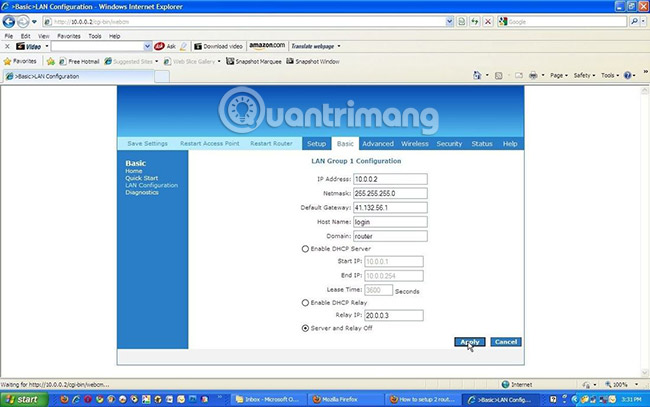Why is IP address 10.0.0.2 used?
10.0.0.2 is the IP address found on many local computer networks, especially corporate networks. Enterprise-class network routers are assigned IP addresses 10.0.0.1 because their local gateway addresses are usually configured to support subnets, and the client IP addresses start from 10.0.0.2.
This address is also the default local address for certain home broadband router device models, coming from brands like Zoom, Edimax, Siemens and Micronet.
Learn IP address 10.0.0.2
- Why is IP 10.0.0.2 popular?
- Automatically assign IP address 10.0.0.2
- Manually assign IP address 10.0.0.2
- Working with address 10.0.0.2
Why is IP 10.0.0.2 popular?

Internet Protocol version 4 (IPv4) defines certain IP addresses that are restricted for private use, meaning they cannot be used for web servers or other Internet servers. The first and largest range of Private IP addresses starts with 10.0.0.0.
The corporate network (which always wants flexibility in allocating a large number of IP addresses) will naturally be intrigued by the use of 10.0.0.0 as their default address, since 10.0.0.2 is one of The first addresses are allocated from that range.
Automatically assign IP address 10.0.0.2
Computers and other devices that support DHCP can automatically receive IP addresses from the router. The router determines which address is assigned from the scope it manages (this scope is called a DHCP pool).
Routers usually assign these addresses sequentially (although the order is not guaranteed). Therefore, 10.0.0.2 is usually the address provided to the first client on the local network connected to the router with IP address 10.0.0.1.
Manually assign IP address 10.0.0.2
Most modern network devices include computers and game consoles, allowing users to manually assign IP addresses to them. This is called a static IP address.
To do so, the phrase "10.0.0.2" must be entered into the network settings configuration screen on the device. The router must be configured to assign the address to that particular device, depending on its physical MAC address.
However, just entering these numbers does not guarantee that this is a valid address for the device to use. The local router must also be configured to include 10.0.0.2 address in its supported scope.

Working with address 10.0.0.2
Accessing a router assigned with IP 10.0.0.2 is as easy as opening an IP address on a regular URL, by visiting http://10.0.0.2.
Most networks assign Private IP addresses like 10.0.0.2 automatically through the use of DHCP. Attempting to manually assign it to the device may also be possible but is not recommended due to the risk of IP address conflicts.
Routers cannot recognize whether a specific address in the pool has been assigned to the client device manually, before assigning it automatically. In the worst case, two different devices on the network will be assigned the same IP address 10.0.0.2, resulting in unsuccessful connections for both devices.
See more:
- Find the router's IP address in Mac OS X
- How to access IP address 192.168.100.1
- Set up a new router using IP address 192.168.1.1
You should read it
- Understanding IP address 192.168.1.3
- Understanding IP address 192.168.1.4
- How to assign a static IP address in Windows 11, 10, 8, 7, XP or Vista
- How to assign static IP addresses in Windows 7, 8, 10, XP or Vista
- 192.168.1.2: Common router IP address
- How to access IP address 192.168.100.1
- What is a static IP address?
- How does IP address and MAC address work in parallel?
May be interested
- Why is Localhost's IP address 127.0.0.1?
 127 is the last network number (network number) in network class a with subnet mask 255.0.0.0. address 127.0.0.1 is the first transfer address in the subnet. address 127.0.0.0 is not used because this is the address of the wired network.
127 is the last network number (network number) in network class a with subnet mask 255.0.0.0. address 127.0.0.1 is the first transfer address in the subnet. address 127.0.0.0 is not used because this is the address of the wired network. - How to Determine the IP Address on a Mac
 when a mac operating system computer connects to a network, it is assigned an address called an ip address (internet protocol address). an ip address has four character ranges separated by spaces, each with a maximum of three characters.
when a mac operating system computer connects to a network, it is assigned an address called an ip address (internet protocol address). an ip address has four character ranges separated by spaces, each with a maximum of three characters. - Things you need to know about Private IP addresses
 private ip address (private ip) is the ip address reserved for internal use via a router or other network address translation (nat) device, completely isolated from external networks.
private ip address (private ip) is the ip address reserved for internal use via a router or other network address translation (nat) device, completely isolated from external networks. - 6 ways to view IP addresses on computers, smartphones or Tablet
 when computers or other devices use the same local network, they send information to each other's ip address. if the new ip address is not located in the same network segment as the computer, the device is currently in use, the connection from the computer to the router will be interrupted.
when computers or other devices use the same local network, they send information to each other's ip address. if the new ip address is not located in the same network segment as the computer, the device is currently in use, the connection from the computer to the router will be interrupted. - How to access IP address 192.168.100.1
 192.168.100.1 is a private ip address that can be assigned to any local network device. it can also be assigned as the default ip address for some router models.
192.168.100.1 is a private ip address that can be assigned to any local network device. it can also be assigned as the default ip address for some router models. - 192.168.1.2: Common router IP address
 192.168.1.2 is a private, default ip address for some types of home broadband routing. it is also often assigned to individual devices on a home network when a router has an ip address of 192.168.1.1.
192.168.1.2 is a private, default ip address for some types of home broadband routing. it is also often assigned to individual devices on a home network when a router has an ip address of 192.168.1.1. - Learn 192.168.0.100 IP address for local network
 192.168.0.100 is a private ip address, meaning it is used exclusively on private networks where it will be the ip address of the router or one of the devices on the network.
192.168.0.100 is a private ip address, meaning it is used exclusively on private networks where it will be the ip address of the router or one of the devices on the network. - How to change the IP address for the phone
 there are many reasons users want to change their ip address and there are many types of user ip addresses that can be changed. it is important to find out what kind of address you want to change before continuing.
there are many reasons users want to change their ip address and there are many types of user ip addresses that can be changed. it is important to find out what kind of address you want to change before continuing. - Learn 193.168.0.1: IP address of broadband router
 every device connected to the internet has an ip address or internet protocol address. there are 2 types of public and private ip addresses. the 192.168.0.1 ip address is a private ip address and is the default for some home broadband routers, mainly d-link and netgear models.
every device connected to the internet has an ip address or internet protocol address. there are 2 types of public and private ip addresses. the 192.168.0.1 ip address is a private ip address and is the default for some home broadband routers, mainly d-link and netgear models. - How to Change the IP Address on a Mac
 changing your ip address can be useful if you want to avoid being attacked by other users who are targeting your ip address, or if you simply want a new online identity from an ip standpoint. you can change your ip address on a mac at any...
changing your ip address can be useful if you want to avoid being attacked by other users who are targeting your ip address, or if you simply want a new online identity from an ip standpoint. you can change your ip address on a mac at any...










 What is the IP address 192.168.1.5 used for?
What is the IP address 192.168.1.5 used for? Frequently asked questions about the default password
Frequently asked questions about the default password Combine 2 networks to speed up
Combine 2 networks to speed up Learn about Wi-Fi 6
Learn about Wi-Fi 6 The best IPAM software and tool to manage IP addresses
The best IPAM software and tool to manage IP addresses